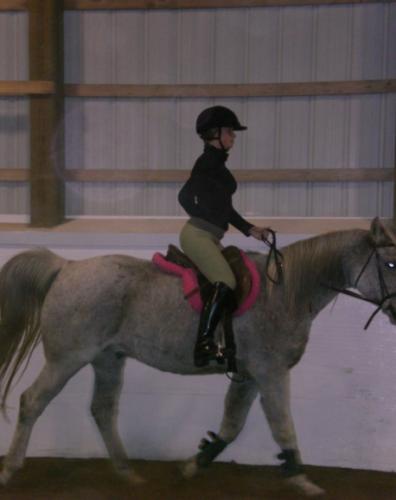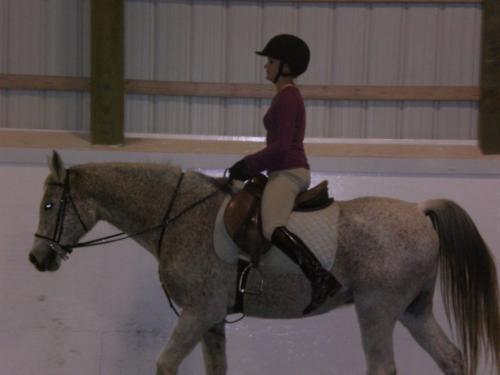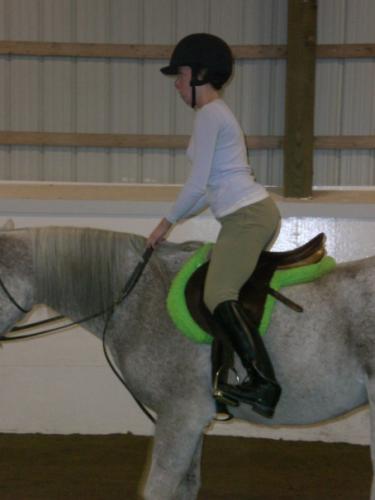Equestrian exercises for the off-season: Part 2
We work our horses to be fit, athletic, strong, sound and flexible; why not do the same for ourselves? This article discusses some ways that we can improve our personal fitness in the saddle.
Here we continue our previous Michigan State University Extension discussion of equestrian exercises for the off-season (part 1), that can help keep equestrians fit. This article will focus on exercises that can be performed while riding. There are several things to keep in mind. Unlike exercises without a horse, when you’re riding, you’ll need cooperation of season or availability of facilities, such as an indoor arena. With a horse there are increased safety concerns. If you feel uncomfortable or unsafe, do not perform that exercise! Finally, performing exercises with your horse will allow for a more realistic experience.
Horseback riding is a sport, and therefore equestrians are athletes. Each time you ride you have committed to a 50:50 partnership with your horse. You should not just be a passenger “along for the ride.” Each time you take the reins, you should also take an active role in your ride. As a rider, one must realize that being a fit and healthy person will reduce the risk of injury. It’s important to take advantage of any opportunity to increase safety. Being an athletic, fit equestrian will allow us to be proactive riders, rather than reactive. It will enable us to respond quicker and smarter to our horses.
The five basic elements to equestrian fitness, according to The Riders Fitness Program, are:
1) Balance
2) Flexibility
3) Strength
4) Mental and physical independence
5) Cardiovascular strength
Before embarking on any type of work out, it is important to your success and comfort to properly stretch your muscles. To increase balance, try this simple exercise. This simple, yet productive exercise can improve a rider’s balance in the saddle. Keep in mind that this exercise can be done in any seat and would be great to try at any gait. While at the posting trot, place one hand at the small of your back and grasp reins with other hand. Keep shoulders even and remain centered in saddle and be sure to not allow your torso to twist (see the first photo to the right).
important to your success and comfort to properly stretch your muscles. To increase balance, try this simple exercise. This simple, yet productive exercise can improve a rider’s balance in the saddle. Keep in mind that this exercise can be done in any seat and would be great to try at any gait. While at the posting trot, place one hand at the small of your back and grasp reins with other hand. Keep shoulders even and remain centered in saddle and be sure to not allow your torso to twist (see the first photo to the right).
The exercise focuses on stability around your pelvis, an important factor in all types of riding. After mastering these exercises, riders will find it easier to tolerate sudden stresses in the saddle. This exercise may be more appropriate for the further advanced rider (see the second photo to the right). This exercise should be performed at a walk only. Be sure to maintain upper-body posture and stability while holding your leg in position. While seated firmly, hold your leg away from the saddle (both ahead of and behind your seat). Your leg should be steady and held away from the horse’s side. Remain centered in saddle throughout exercise and you’ll be sure to target the right muscles.
This exercise should be performed at a walk only. Be sure to maintain upper-body posture and stability while holding your leg in position. While seated firmly, hold your leg away from the saddle (both ahead of and behind your seat). Your leg should be steady and held away from the horse’s side. Remain centered in saddle throughout exercise and you’ll be sure to target the right muscles.
The rider in this photo is holding her leg away from the horse and behind her seat. Be careful to not brush the horse’s side with your heel, as the flank is a sensitive area.
The final exercise discuss in this article is the 2-point position (see the last photo to the right). In this exercise the rider will come up out of the seat in more of a “standing position”. This exercise will improve posture and is certainly a strength building exercise for the lower-body. Although the 2-point position is generally associated with hunt seat riding, be assured this can be done to suit any discipline. Each part of your body should receive attention while in the 2-point position. Maintain stable lower-legs while your pelvis is elevated out of saddle. Also be sure to maintain contact with your horse’s mouth with steady hands. Lastly, keep shoulders back and chest open and body centered over your horse.
the last photo to the right). In this exercise the rider will come up out of the seat in more of a “standing position”. This exercise will improve posture and is certainly a strength building exercise for the lower-body. Although the 2-point position is generally associated with hunt seat riding, be assured this can be done to suit any discipline. Each part of your body should receive attention while in the 2-point position. Maintain stable lower-legs while your pelvis is elevated out of saddle. Also be sure to maintain contact with your horse’s mouth with steady hands. Lastly, keep shoulders back and chest open and body centered over your horse.
Don’t forget: Horseback riding is a sport, and therefore equestrians are athletes. You may want to consult your doctor before beginning any such physical activity. Do not perform any exercise that you aren’t prepared for, especially if you are riding a horse.



 Print
Print Email
Email





